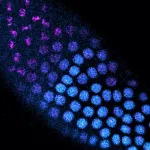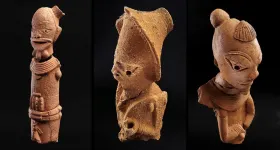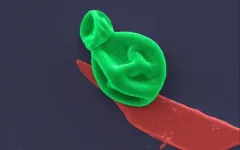(Press-News.org) A team of UBC Okanagan researchers has determined that the type of fats a mother consumes while breastfeeding can have long-term implications on her infant's gut health.
Dr. Deanna Gibson, a biochemistry researcher, along with Dr. Sanjoy Ghosh, who studies the biochemical aspects of dietary fats, teamed up with chemistry and molecular biology researcher Dr. Wesley Zandberg. The team, who conducts research in the Irving K. Barber Faculty of Science, explored the role of feeding dietary fat to gestating rodents to determine the generational effects of fat exposure on their offspring.
"The goal was to investigate how maternal dietary habits can impact an offspring's gut microbial communities and their associated sugar molecule patterns which can be important in immune responses to infectious disease," says Dr. Gibson, who studies gut health and immunity as well as causes of acute or chronic diseases like inflammatory bowel disease.
Their study suggests that the type of fat consumed during breastfeeding could differentially impact an infant's intestinal microbial communities, immune development and disease risk.
The three main classes of fatty acids include saturated (SFA), found in meats and dairy products, monounsaturated fats (MUFA), found in plant-based liquid oils, and polyunsaturated fatty acids (PUFAs), found in some nuts, fish and shellfish. PUFAs are further characterized as either n-3 PUFAs or n-6 PUFAs, based on the number and positions of double bonds in the acyl chain.
Previous research has determined both n-3 PUFAs and n-6 PUFAs can have a negative impact on intestinal infections such as Enteropathogenic E. coli, Clostridium difficile, salmonella and gastrointestinal illnesses from eating poorly prepared or undercooked food or drinking contaminated water. In contrast, diets rich in MUFAs and SFAs have been shown to be largely protective against these infections.
Dr. Gibson's latest research states the beneficial properties of milk fat, or saturated fats, during the pre-and postnatal period might improve protection against infectious intestinal disease during adulthood particularly when a source of n-3 PUFAs are combined with saturated fats.
"Our findings challenge current dietary recommendations and reveal that maternal intake of fat has transgenerational impacts on their offspring's susceptibility to intestinal infection, likely enabled through microbe-immune interactions," says Dr. Gibson.
Global consumption of unsaturated fatty acids has increased significantly between 1990 and 2010, she adds, while people are consuming lower amounts of saturated fats during pregnancy because of recommendations to reduce saturated fat intake.
"Although it has been known for decades that high-fat diets can directly alter inflammatory responses, recent studies have only just begun to appreciate how fatty acid classes may have discrete effects on inflammation, and can shift host responses to an infection," says Dr. Gibson.
Dietary fatty acids can impact inflammatory processes including defensive inflammatory responses following an intestinal infection. This can affect the severity of disease, making dietary fatty acids an important consideration in predicting disease risk, Dr. Gibson explains.
Researchers believe it's a combination of dietary fat-host interactions with the intestinal bacteriome that can determine the severity of these infections. The intestinal bacteriome, Dr. Gibson explains, is established during infancy and plays a critical role in aiding immune system maturation and providing a barrier against colonization with potential pathogens.
And Dr. Ghosh notes this latest research suggests current health guidelines should be reevaluated.
"Currently, Canadian dietary guidelines recommend nursing mothers replace foods rich in SFA with dietary PUFAs, with an emphasis on consuming n-6 and n-3 PUFAs," Dr. Ghosh says. "Given that PUFAs worsened disease outcomes in postnatal diet studies, in our views, these recommendations should be reconsidered."
While breast milk protein and carbohydrate concentrations remain relatively inert, fatty acid contents vary considerably and are influenced by maternal fat intake.
"Overall, we conclude that maternal consumption of various dietary fat types alters the establishment of their child's bacteriome and can have lasting consequences on their ability to respond to infection during adulthood," says Dr. Gibson. "At the same time, we show that maternal diets rich in SFA, provide a host-microbe relationship in their offspring that protects against disease."
It's important to understand that the intestinal bacteriome is established during infancy because it plays a critical role in aiding immune system maturation which can provide a barrier to potential pathogens, explains Dr. Zandberg. He also notes a healthy bacteriome is dependent on early-life nutrition.
"Sugars decorate important proteins in the gut," says Dr. Zandberg. "Their patterns are altered in the offspring due to the dietary choices of the mother during gestation and lactation. The change in patterns is associated with changes in the ability of the infant to fight off infectious disease in our model."
INFORMATION:
The research, published recently in Molecular Nutrition & Food Research, was funded by the Bill and Melinda Gates Foundation and awarded to Drs. Gibson and Ghosh as well as other organizations including the Natural Sciences and Engineering Research Council of Canada, Crohn's and Colitis Canada, Dairy Farmers of Canada, and a scholarship to the study's first author Candice Quin from the Canadian Institute of Health Research.
HANOVER, N.H. - April 14, 2021 - Scientists have searched for years to understand how cells measure their size. Cell size is critical. It's what regulates cell division in a growing organism. When the microscopic structures double in size, they divide. One cell turns into two. Two cells turn into four. The process repeats until an organism has enough cells. And then it stops. Or at least it is supposed to.
The complete chain of events that causes cell division to stop at the right time is what has confounded scientists. Beyond being a textbook problem, the question relates to serious medical challenges: ...
LOS ANGELES (April 13, 2021) -- The Lundquist Institute (TLI) Investigator Dong W. Chang, MD, and his colleagues' study on critically ill patients and ICU treatments was published in JAMA Internal Medicine. The study - "Evaluation of Time-Limited Trials Among Critically Ill Patients with Advanced Medical Illnesses and Reduction of Nonbeneficial ICU Treatments" - found that training physicians to communicate with family members of critically ill patients using a structured approach, which promotes shared decision-making, improved the quality of family meetings. This intervention was associated with reductions in invasive ICU treatments that prolonged suffering without benefit for patients and their families.
"Invasive ICU treatments are frequently delivered to patients ...
In April 2019, scientists released the first image of a black hole in galaxy M87 using the Event Horizon Telescope (EHT). However, that remarkable achievement was just the beginning of the science story to be told.
Data from 19 observatories released today promise to give unparalleled insight into this black hole and the system it powers, and to improve tests of Einstein's General Theory of Relativity.
"We knew that the first direct image of a black hole would be groundbreaking," says Kazuhiro Hada of the National Astronomical Observatory of Japan, a co-author of a new study published in The Astrophysical Journal Letters that ...
If global warming continues unchecked, summer monsoon rainfall in India will become stronger and more erratic. This is the central finding of an analysis by a team of German researchers that compared more than 30 state-of-the-art climate models from all around the world. The study predicts more extremely wet years in the future - with potentially grave consequences for more than one billion people's well-being, economy, food systems and agriculture.
"We have found robust evidence for an exponential dependence: For every degree Celsius of warming, monsoon rainfalls will likely increase by about 5%," says lead author Anja Katzenberger from the Potsdam-Institute ...
A team of scientists, led by the University of Bristol, with colleagues from Goethe University, Frankfurt, has found the first evidence for ancient honey hunting, locked inside pottery fragments from prehistoric West Africa, dating back some 3,500 years ago.
Honeybees are an iconic species, being the world's most important pollinator of food crops. Honeybee hive products, including beeswax, honey and pollen, used both for food and medicinal purposes, support livelihoods and provide sources of income for local communities across much of Africa, through both beekeeping ...
A potential treatment for dementia and epilepsy could look to reduce the amounts of a toxic gas in the brain has been revealed in a new study using rat brain cells.
The research published in Scientific Reports today [Wednesday 14 April] shows that treatments to reduce levels of hydrogen sulfide (H2S) in the brain may help to ward off damage caused by the gas. By testing rat brain cells, the team of scientists from the University of Reading, University of Leeds and John Hopkins University in the USA found that H2S is involved in blocking a key brain cell gateway ...
If you were to visit the Great Basin and Colorado Plateau a thousand years ago, you'd find conditions remarkably familiar to the present. The climate was warm, but drier than today. There were large populations of Indigenous people known as the Fremont, a who hunted and grew crops in the area. With similar climate and moderate human activity, you might expect to see the types of wildfires that are now common to the American West: infrequent, gigantic and devastating. But you'd be wrong.
In a new study led by the University of Utah, researchers found that ...
CLEVELAND, Ohio (April 14, 2021)--Despite all the advances in medicine, some basic questions remain. For example, people cannot be told with any certainty how long they'll live. Nor can it be predicted exactly when a woman's childbearing years will end. However, a new study offers insights into factors that might predict a woman's age at natural menopause. Study results are published online today in Menopause, the journal of The North American Menopause Society (NAMS).
Factors that affect age at natural menopause are one of the most frequently studied topics in menopause-related research in recent decades, and with good reason. Knowing when a woman will enter menopause could be ...
Researchers have developed a new superbug-destroying coating that could be used on wound dressings and implants to prevent and treat potentially deadly bacterial and fungal infections.
The material is one of the thinnest antimicrobial coatings developed to date and is effective against a broad range of drug-resistant bacteria and fungal cells, while leaving human cells unharmed.
Antibiotic resistance is a major global health threat, causing at least 700,000 deaths a year. Without the development of new antibacterial therapies, the death toll could rise to 10 million people a year by 2050, equating to $US100 trillion in health care costs.
While the health burden of fungal infections is less recognised, globally they kill about ...
Researchers from University of Hawaii and Cornell University published a new paper in the Journal of Marketing that explores the challenges and opportunities with nonprofit fundraising to provide organizations with strategies they can use to increase sustainable giving and profitability.
The study, forthcoming in the Journal of Marketing, is titled "Managing Members, Donors, and Member-Donors for Effective Non-profit Fundraising" and is authored by Sungjin Kim, Sachin Gupta, and Clarence Lee.
Individual philanthropy is the primary funding source for many nonprofit organizations. A major challenge facing such organizations ...





